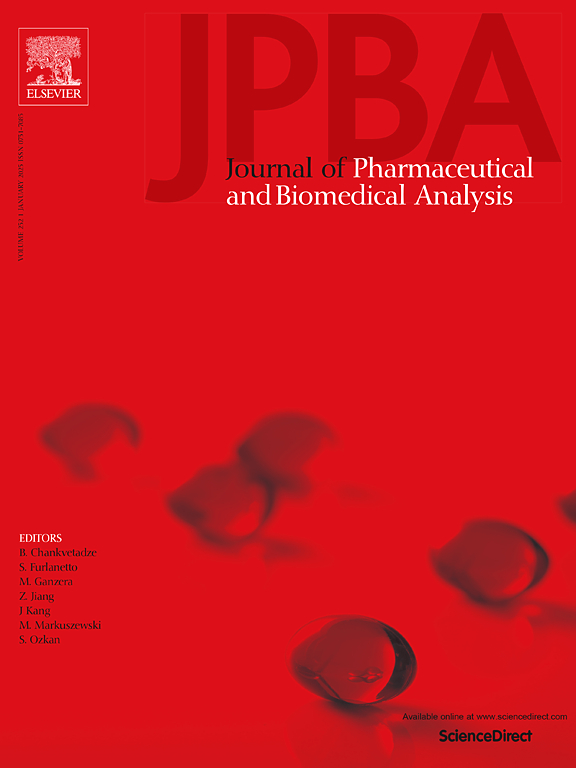Understanding the clearance behaviour of elemental leachables during ultrafiltration/diafiltration from process streams
IF 3.1
3区 医学
Q2 CHEMISTRY, ANALYTICAL
Journal of pharmaceutical and biomedical analysis
Pub Date : 2025-05-12
DOI:10.1016/j.jpba.2025.116963
引用次数: 0
Abstract
The introduction of trace elemental impurities through the use of single use technologies (SUTs) during biopharmaceutical manufacturing is a key concern as the presence of process equipment related leachables (PERLs) such as process related elemental impurities has potential harmful implications on product quality and patient safety. ICH Q3A provides a regulatory road map for PERLs but excludes biologic drugs like monoclonal antibody (mAb) therapies. Consequently, the industry lacks a synchronized, risk-based testing strategy for PERLs based on the likelihood of their presence in the final drug product. Ultrafiltration and diafiltration (UF/DF) operations have been demonstrated to clear leachables from the drug product during downstream purification. Hence, it is attractive to characterize PERL behavior during UF/DF to inform subsequent extractable and leachable (E&L) evaluation of the formulated biologic. The reduction capacity of twenty-two elements spiked into concentrated protein samples during UF/DF processes was investigated, using an inductively coupled plasma-mass spectrometry (ICP-MS) method, which was developed and validated according to ICH Q2 (R1) guidelines. Most elements (18) were efficiently cleared (>97 %), representing a 100-fold (2-log) reduction or higher after 10 diavolumes. Clearance was linked to UF/DF process parameters, most notably pH, as well as to the physicochemical properties of the studied elements. Mathematical models based on Orthogonal Partial Least Squares (OPLS) regression were developed and validated using the sieving coefficient to characterize and predict the clearance behavior of elemental impurities during UF/DF. Results from this study lay a solid foundation for the understanding and prediction of UF/DF capacity to remove elemental leachables. PERL clearance modelling emerges as a valuable platform to support industry and regulatory bodies in developing sophisticated risk-based PERL testing strategies, ultimately ensuring patient safety. The data presented herein demonstrate the significant risk reduction that the UF/DF process provides for processing steps upstream in mAbs and other biologics processes.
了解工艺流程中超滤/滤过程中元素浸出物的清除行为
在生物制药生产过程中,通过使用一次性技术(SUTs)引入微量元素杂质是一个关键问题,因为与工艺设备相关的浸出物(perl)的存在,如与工艺相关的元素杂质,对产品质量和患者安全具有潜在的有害影响。ICH Q3A提供了perl的监管路线图,但不包括单克隆抗体(mAb)疗法等生物药物。因此,该行业缺乏基于perl在最终药品中存在可能性的同步的、基于风险的测试策略。超滤和滤(UF/DF)操作已被证明可以在下游纯化过程中清除药品中的可浸出物。因此,在UF/DF过程中表征PERL的行为是很有吸引力的,以告知随后对配方生物制剂的可提取和可浸出性(E&;L)评估。采用电感耦合等离子体质谱法(ICP-MS)研究了浓缩蛋白样品在UF/DF过程中22种元素的还原能力,该方法根据ICH Q2 (R1)指南开发并验证。大多数元素(18)被有效清除(>97 %),在10次抽吸后减少了100倍(2-log)或更高。去除率与UF/DF工艺参数有关,特别是pH值,以及所研究元素的物理化学性质。建立了基于正交偏最小二乘(ops)回归的数学模型,并利用筛选系数来表征和预测UF/DF过程中元素杂质的清除行为。研究结果为了解和预测UF/DF去除元素浸出物的能力奠定了坚实的基础。PERL清除建模作为一个有价值的平台出现,支持行业和监管机构开发复杂的基于风险的PERL测试策略,最终确保患者安全。本文提供的数据表明,UF/DF工艺为单克隆抗体和其他生物制剂工艺的上游加工步骤提供了显著的风险降低。
本文章由计算机程序翻译,如有差异,请以英文原文为准。
求助全文
约1分钟内获得全文
求助全文
来源期刊
CiteScore
6.70
自引率
5.90%
发文量
588
审稿时长
37 days
期刊介绍:
This journal is an international medium directed towards the needs of academic, clinical, government and industrial analysis by publishing original research reports and critical reviews on pharmaceutical and biomedical analysis. It covers the interdisciplinary aspects of analysis in the pharmaceutical, biomedical and clinical sciences, including developments in analytical methodology, instrumentation, computation and interpretation. Submissions on novel applications focusing on drug purity and stability studies, pharmacokinetics, therapeutic monitoring, metabolic profiling; drug-related aspects of analytical biochemistry and forensic toxicology; quality assurance in the pharmaceutical industry are also welcome.
Studies from areas of well established and poorly selective methods, such as UV-VIS spectrophotometry (including derivative and multi-wavelength measurements), basic electroanalytical (potentiometric, polarographic and voltammetric) methods, fluorimetry, flow-injection analysis, etc. are accepted for publication in exceptional cases only, if a unique and substantial advantage over presently known systems is demonstrated. The same applies to the assay of simple drug formulations by any kind of methods and the determination of drugs in biological samples based merely on spiked samples. Drug purity/stability studies should contain information on the structure elucidation of the impurities/degradants.

 求助内容:
求助内容: 应助结果提醒方式:
应助结果提醒方式:


